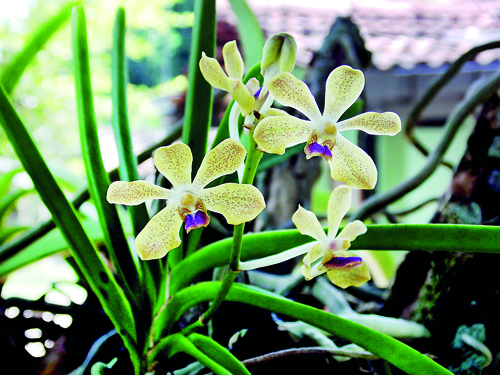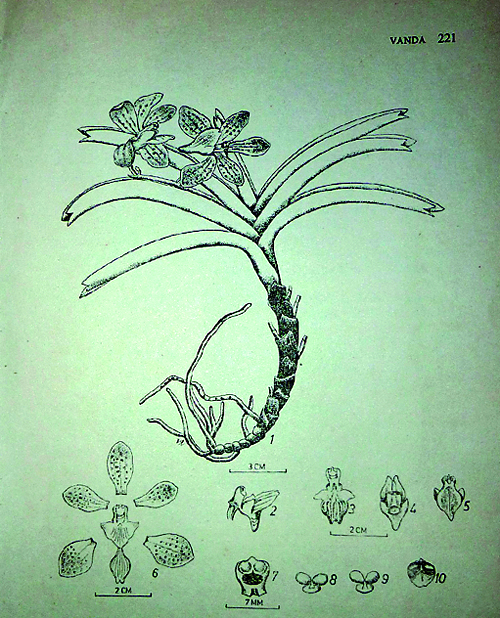Vanda thwaitesii blooms from extinction
A chance encounter with a Landmaster carrying logs for a bakery furnace has led to the uncovering of an orchid which has been hidden from human view for more than 150 years.
Researcher and environmentalist Ajantha Palihawadana with a passion for native orchids was on his way to the east when he overtook the Landmaster packed with logs at Kurunegala.
As he was wont to do, whenever he saw large trees cut down by the roadside and lying on their side with beautiful orchids “frying and drying” in the heat of the sun, he could not resist taking a look and attempting a rescue.

Vanda thwaitesii found after 150 years. Pix courtesy Ajantha Palihawadana
What he did not realise that day, three years ago, was that he had stumbled on to an orchid plant which was confined only to drawings at the Peradeniya Botanical Gardens and a black-and-white sketch in ‘Flora of Ceylon Volume II’. Not a single specimen was available either at the Peradeniya Botanical Gardens or at Kew Gardens in England where many of the plants from British colonies are preserved.
It was Vanda thwaitesii. That revelation came only this year in April.
Chatting up the driver of the parked Landmaster, Ajantha had asked him whether he could remove the orchids which would otherwise be consigned to the flames of the paan poranuwa along with the logs. When the driver readily agreed, not only did Ajantha remove the orchid plants tenderly but he also put his research trip to the east on hold, turned around and returned to Colombo, to hand over the plants to someone to look after while he was gone.
“One plant looked different,” says Ajantha, whose love of native orchids blossomed after he along with his uncle, Siri Palihawadana, looked on in wonder as a ground orchid flowered in the garden of their ancestral home in Matara.
The life-long lure of these “amazing plants” has remained for Ajantha since his boyhood, like the beetle which he watched flitting from

Ajantha Palihawadana
one orchid to another, pollinating them.
“The excitement in my heart grew,” he concedes, as he kept his eyes riveted on the beetle which would “settle on the lip of the orchid, with the pollen getting stuck on its head when it poked it inside the flower”.
“The orchid lip is a funny thing,” laughs Ajantha, adding that, thereafter the beetle would go to another flower and do the same, dabbing the pollen on that.
It was the beginning of a meandering journey as an adult through the Sinharaja rainforest in the footsteps of one of the best known entomologists P.B. Karunaratne, now no more, learning about these fascinating plants, with serious research on orchids being conducted by Ajantha for more than two decades. A while ago, Ajantha had been part of ‘Orchid Rescue’ which along with the Forest Department saved three vanloads including the Vesak orchid from being submerged by the Kukule Ganga hydro project.
Ajantha, in fact, was the first to design a poster on native orchids in collaboration with the Marga Institute and went on to describe certain new species. He is also a member of the Orchid Specialist Group of the International Union for Conservation of Nature (IUCN) and the Species Specialist of the Executive Committee of the Orchid Circle of Ceylon.

The drawing of the plant in the ‘Flora of Ceylon’
But what intrigued him was Vanda thwaitesii, for it was believed to be extinct. It had been described in ‘Flora of Ceylon’ as being seen in the Hunnasgiriya district, which Ajantha says would have been an administrative district under colonial rule.
After studying maps, he deduced that it would have been found in the Matale area.
In early May, this year when Ajantha got the call from the person who was looking after the orchids rescued from the Landmaster that the plants were flowering, he rushed there only to see “an amuthu malak” (strange flower) amongst the lot.
Heart racing, when Ajantha pointed out to the ‘guardian’ of the flowers what he thought, the reaction at first had been of disbelief, then the exclamation, “Ammata siri, wede hari”. (“Oh gosh, it has worked.”)
Excitement mounting, he then contacted the Director-General of the Department of National Botanical Gardens, Dr. Siril Wijesundara, sending him photographs of the flowers. When the latter suggested he take the measurements, he did so, and the blooming beauties exactly matched the original description.
With action being taken to propagate the plants and also carry out DNA testing, the survival of Vanda thwaitesii seems assured.
“We have pulled back this beautiful orchid from the brink of extinction,” Ajantha says simply.
| Who was Thwaites?
This orchid with yellowish flowers dotted with red is named after British naturalist George Henry Kendrick Thwaites (1812-1882) who had been in then Ceylon for 31 long years. Described as having “immense calibre and energy”, he had taken up duties as the Superintendent of the Peradeniya Botanical Gardens from 1849-1880. Credited with laying a strong foundation for botanical studies and heavily contributing to the science, Thwaites had compiled a comprehensive list of flora called the ‘Enumeratio Plantarum Zeylaniae’, published in five parts from 1859-1864. It was an enumeration of Ceylon plants, with descriptions of the new and little known genera and species, observations on their habitats, uses and native names done by Thwaites, assisted in the identification of the species and synonymy by J.D. Hooker. Orchids found up to that period, all of 145 species, have his critical comments and observations, research reveals, while he had also initiated the ‘Ceylon Plants’ series which includes information on hundreds of species. He has been honoured by naming the plant genera, Thwaitesia and Kendrickia — after him. The orchids named after him are Eria thwaitesii, Bulbophyllum thwaitesii, Liparis thwaitesii, Malaxis thwaitesii, Oberonia thwaitesii and also the re-discovered Vanda thwaitesii. After retiring, unmarried Thwaites lived in the ‘Fairieland’ bungalow above Kandy until his death in September 1882. Its first description and others that followed “It is a good finding,” said the Director-General of the Department of National Botanical Gardens, Dr. Siril Wijesundara, as there is no specimen even at the Peradeniya Botanical Gardens. Although he has not seen the plant, the photographs sent by Ajantha indicate that it is Vanda thwaitesii, he said. Dr. Wijesundara added that it would also be important to find the original locality in which these plants are, to take action to conserve the remaining population. First discovered and named in 1864 as Aerides tessellatum by George Thwaites, it was in 1898 that it was described after looking at drawings by William de Alwis available at the Peradeniya Botanical Gardens and re-named as Vanda thwaitesii in the ‘Flora of Ceylon’ by J.D. Hooker. It is described in the Flora of Ceylon as an epiphyte with a non-pseudo bulbous stem 15-30 cm long; lower internodes covered with brown coriaceous sheaths. Leaves 7.5-10 cm long, thick, coriaceous, falcately recurving, bifid at apex and sheaths closely imbricating at the base. Flowers 3.7 cm broad, yellow-green, streaked and spotted with red and white or pale yellow, in 2 or 3 flowered stout racemes; peduncle green, 10 cm long. Flora bracts very small. Distr. Endemic, very rare, on trees in the Hunnasgiriya district.
|


